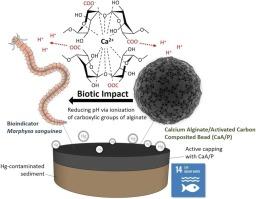海藻酸钙/活性炭复合材料对活性封顶沉积物中汞污染的控制及血棉藻的生物响应
IF 11.3
1区 环境科学与生态学
Q1 ENGINEERING, ENVIRONMENTAL
引用次数: 0
摘要
人为活动和工业活动已向水圈释放了大量汞。汞最终沉积在沉积物中,并可能重新释放到水环境中,威胁生态系统。主动封顶是一种较为合适的修复方法,其成本相对较低,且具有原位去污的可行性。粉末活性炭(PAC)是常用的活性封盖材料;凝胶化可以增加PAC的粒径,有利于GAC与沉积物的分离。然而,凝胶化可能会影响底栖生态系统。本研究制备了海藻酸钙- pac微珠(CaA/P)作为活性封盖材料,以了解海藻酸钙凝胶化对底栖生物指示剂(即血Marphysa sanguinea)的不利影响。顺序萃取结果表明,污染沉积物中90%以上的汞仍停留在残留相中。在3%和10%的封顶剂量下,PAC封顶效果良好,成活率超过60%,生物重量相同。然而,以10%的CaA/P封顶会使血Marphysa sanguinea的pH值低于可耐受值(7.5),影响其存活。总体而言,尽管CaA/P在沉积物中具有可分离的粒径(≈2 mm),但过量(10%)的上限会影响生物体的生存。本文章由计算机程序翻译,如有差异,请以英文原文为准。

Mercury pollution control and Marphysa sanguinea bio-response in active-capped sediment with calcium alginate/activated carbon composite
Anthropogenic and industrial activities have released large amounts of mercury (Hg) into the hydrosphere. Hg ultimately deposits in sediments and could be re-released into the water environment, threatening the ecological system. Active capping is considered a suitable remediation method due to its relatively low cost and in-situ decontamination feasibility. Powder activated carbon (PAC) is commonly applied as an active capping material; gelation could increase PAC’s particle size to facilitate separation of GAC from sediment. Nevertheless, gelation may impact the benthic ecosystem. This work prepared calcium alginate-PAC beads (CaA/P) as an active capping material to comprehend the adverse effects of calcium-alginate-gelation on a benthic bioindicator (i.e., Marphysa sanguinea). Sequential extraction procedure results indicate over 90 % of Hg in the contaminated sediments remained in the residual phase. PAC capping shows positive results with over 60 % survival and the same weight of biotas at 3 % and 10 % capping dosage. However, capping with a 10 % dosage of CaA/P lowers the pH to that below a tolerable value (7.5) for Marphysa sanguinea, impacting its survival. Overall, though CaA/P has a separable particle size (≈ 2 mm) in sediment, capping with an excess dosage (10 %) of it impacts the organism’s survival.
求助全文
通过发布文献求助,成功后即可免费获取论文全文。
去求助
来源期刊

Journal of Hazardous Materials
工程技术-工程:环境
CiteScore
25.40
自引率
5.90%
发文量
3059
审稿时长
58 days
期刊介绍:
The Journal of Hazardous Materials serves as a global platform for promoting cutting-edge research in the field of Environmental Science and Engineering. Our publication features a wide range of articles, including full-length research papers, review articles, and perspectives, with the aim of enhancing our understanding of the dangers and risks associated with various materials concerning public health and the environment. It is important to note that the term "environmental contaminants" refers specifically to substances that pose hazardous effects through contamination, while excluding those that do not have such impacts on the environment or human health. Moreover, we emphasize the distinction between wastes and hazardous materials in order to provide further clarity on the scope of the journal. We have a keen interest in exploring specific compounds and microbial agents that have adverse effects on the environment.
 求助内容:
求助内容: 应助结果提醒方式:
应助结果提醒方式:


